SINGAPORE
Pipe Details
- Refining Company
- Ambient temperature to 80 C
- Pressure: 50psig
- Sulfur acid concentration 4% – 98% weight
- 18″ pipe
- 100% assumed wall loss
Summary
Sulfuric Acid discharge in the pipe can be in the range of concentration 4 to 98% weight so creating a very corrosive environment. Existing competitor wrap did not perform up to expectation. In certain areas of the competitor wrap, there are traces of black stains.The competitor wrap was installed when there was no leak on the pipe so the pipe has since deteriorated to a 100% wall loss scenario in certain parts and the competitor wrap installed is not compatible to the line content. Competitor was called in to add more wraps and monitored to ensure that the leak stops before a remedial solution is put into place. Customer decides to call CSNRI for an alternative solution.
To design an engineered DiamondWrap solution and wrap over the existing Competitor wrap onto the Furmanite Clamp as the anchor point. The DiamondWrap kit selected must be able to withstand the pressure, temperature as well as the harsh chemical Sulfuric acid ranging from 4 to 98% at ambient up to 80 C.
The ASME PCCI2 calculation using parameters from DiamondWrap states that 2 wraps of the BA type fabric is required to restore the pipe back to its original designed condition. The selection of DiamondWrap epoxy is the Acid kit to withstand the harsh Sulfuric acid 4 – 98%.
The existing competitor wrap was sand papered down to give it a good surface for adhesion. The anchor locations – Sides of clamp, Flanges, past the end of the existing wrap where fresh pipe is found, are prepared properly using a sander, MBX tool and wire brushing. Putty is first applied to places where smoothening is required – Sides of clamps, Flange, Y-branches.
Wrapping of the straight portion is completed in stages where the pipe support needs to be shifted to the completed Diamond wrap section so that the rest can be completed. Due to the huge transition from the pipe to the clamp, a good amount of putty is prescribed. As the putty is the famed Acid resistant type where it can “foam” up if too much of it is applied at any one point, the work has to be progressive.
Once all the putties are applied, we use the sander to smoothen down the putty surface so that when we apply the carbon composite layer, the smooth transition will facilitate the easy laying of the carbon fibers.
(*The wrapping was carried out after acid resistant putty cured and confirmation of no leakage status was conducted, by means of gas detectors and visual inspection).
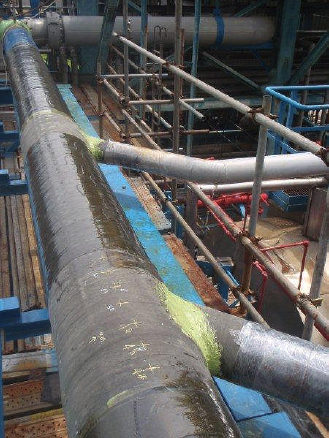
Application of the putty (Green color) at the Y-joints in preparation of the wrap. The grey area where it is not shiny with the yellow markings is the existing competitor wrap. The shiny areas are already wrapped with DiamondWrap.
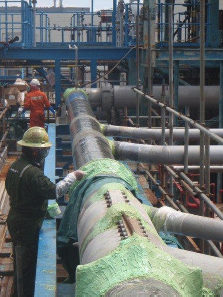
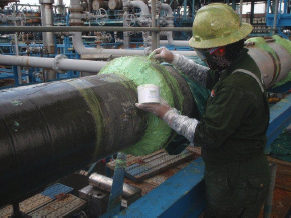
Application of putty in stages for the flange and the clamp.
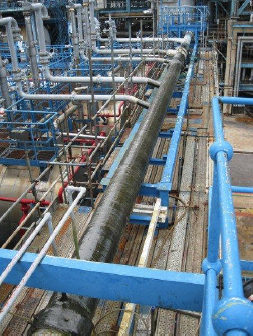
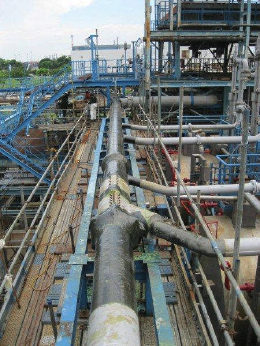
Job completed. Wrapping is to 8” onto the clamp on both ends where you can see on the picture on the right. The flange is being wrapped entirely and on the picture on the left, the wrap goes onto a clamp as well.

